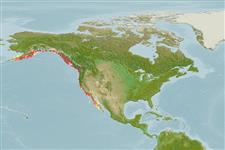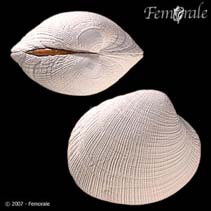Leukoma staminea (Conrad, 1837)
Pacific littleneck| Native range | All suitable habitat | Point map | Year 2050 |

|
| This map was computer-generated and has not yet been reviewed. |
| Leukoma staminea AquaMaps Data sources: GBIF OBIS |
Classification / Names Common names | Synonyms | CoL | ITIS | WoRMS
Bivalvia | Venerida | Veneridae
Environment: milieu / climate zone / depth range / distribution range Ecology
Benthic; depth range 0 - 46 m (Ref. 95344). Boreal, preferred 8°C (Ref. 107945); 60°N - 22°N, 166°E - 109°W
Distribution Countries | FAO areas | Ecosystems | Occurrences | Introductions
Pacific Ocean: West to east Bering Sea, Aleutian to Baja California.
Length at first maturity / Size / Weight / Age
Maturity: Lm ?, range 2 - 3.5 cm Max length : 7.5 cm SHL male/unsexed; (Ref. 95344); common length : 6.4 cm SHL male/unsexed; (Ref. 78182); max. reported age: 16 years (Ref. 104675)
Maximum depth from Ref. 104447. Buries in gravel, sand and mud to more than 10 cm deep along the mid-intertidal zone (Ref. 95344). Preyed upon by naticid gastropods (Ref. 100855). Suspension-feeder (Ref. 78182). In general, suspension feeding bivalves mainly depend on phytoplankton and detritus material for nutrition (Ref. 107088).
Life cycle and mating behavior Maturity | Reproduction | Spawning | Eggs | Fecundity | Larvae
Members of the class Bivalvia are mostly gonochoric, some are protandric hermaphrodites. Life cycle: Embryos develop into free-swimming trocophore larvae, succeeded by the bivalve veliger, resembling a miniature clam (Ref. 833). Eggs are discharged through the siphon (Ref. 104667). Spawning: Two periods of high temperature and two spawning peaks may occur in summer due to strong water temperature fluctuations while only one temperature and spawning peak may be expected in a warmer than normal year (Ref. 78182).
Main reference
References | Coordinator | Collaborators
Shaw, W.N. 1986. (Ref. 78182)
IUCN Red List Status (Ref. 130435)
CITES status (Ref. 108899)
Not Evaluated
CMS (Ref. 116361)
Not Evaluated
Threat to humans
Human uses
Fisheries: commercial
FAO - Aquaculture: production; Fisheries: landings | FishSource | Sea Around Us
Tools
More information
Internet sources
BHL | BOLD Systems | CISTI | DiscoverLife | FAO(Fisheries: ; publication : search) | Fishipedia | GenBank (genome, nucleotide) | GloBI | Gomexsi | Google Books | Google Scholar | Google | PubMed | Tree of Life | Wikipedia (Go, Search) | Zoological Record
Estimates based on models
Preferred temperature
(Ref. 115969): 7.3 - 15.7, mean 9.8 (based on 90 cells).
Resilience
(Ref. 69278):
Medium, minimum population doubling time 1.4 - 4.4 years (K=0.19; tm=2.5; tmax=16).
Nutrients: Calcium = 149 [71, 228] mg/100g; Iron = 8.53 [1.95, 15.11] mg/100g; Protein = 9.88 [8.64, 11.12] %; Omega3 = 0.313 [0.202, 0.423] g/100g; Selenium = 61 [50, 72] μg/100g; VitaminA = 0 μg/100g; Zinc = 2.04 [0.56, 3.51] mg/100g (wet weight).



